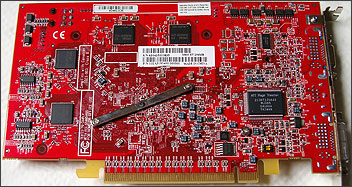MSI's RX800 XT
The PCI Express version is powered by a full (four pixel quad pipelines) R420 GPU at 500MHz, 20MHz down from the AGP-based Platinum Edition. Joined by Samsung's GDDR3 DRAMs, eight of those 256Mbit, GC20-variant devices give X800 XT its full 256MB of memory, clocked at the GC20's 1000MHz maximum. A Rage Theater 200 ASIC provides MSI's X800 XT with full VIVO ability, more about which later. Being a PCI Express board that needs more power than a standard PEG16X slot can provide, the RX800 XT needs an external power source so the new 6-pin power connector is provided.Like the X800 XT PE reference board, the MSI RX800 XT weighs less than 350 grams. MSI don't change the reference cooler at all, simply branding the one-slot copper cooler as their own using a sticker. Being identical to the reference board in terms of cooler, that means an unobtrusive aural profile that rarely bothers, even at full speed when playing demanding games. The fan is speed adjusted based on temperature. The pitch of the noise as the fan changes is minimal and since it's the pitch of the generated noise that the human ear notices most, moreso than the actual decibel level, that's a good thing and the RX800 XT is fairly quiet.
Pictorial proof?
The XT doesn't feature dual DVI, the only real let down in specification. If you're spending more than £300 on a graphics card, it's something that should definitely be included. As a recent upgrader to dual LCD monitors myself, each one with a DVI input, I really lament it not being included in such a premium graphics accelerator.
Let's see how the AGP version differs.











